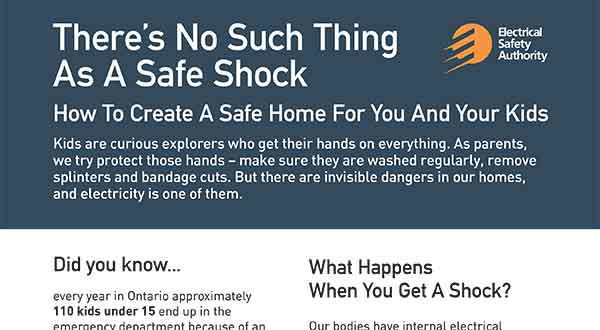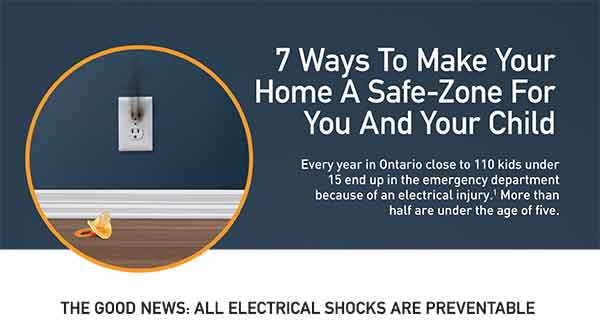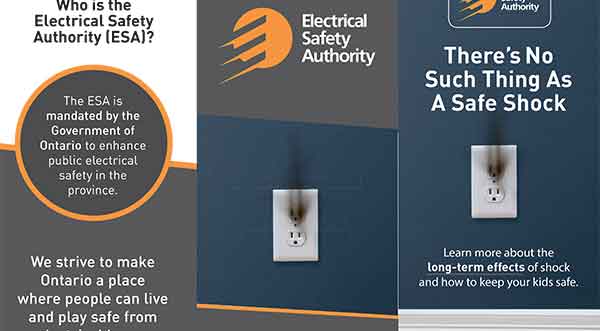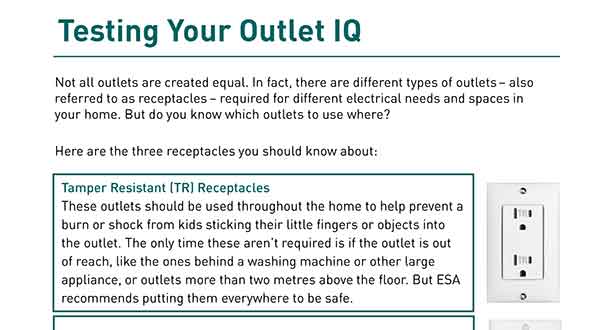
Preventing Electrical Shocks
There’s No Such Thing as a Safe Shock.
Most Ontarians say they’ve received a shock. Although you might brush off a little zap from a toaster, even low-voltage shocks can have serious long-term aftereffects, such as memory loss, anxiety, and pins and needles.
Kids are especially curious and are natural explorers who get their hands on everything, which puts them at risk for shock. On average, more than 110 kids under 15 end up in the emergency department each year in Ontario due to an electrical injury. More than half are under the age of five.
Watch this quick video to find out what happens to your body when you receive a shock.
The good news is electrical shocks are preventable. ESA can show you how with safety tips and downloadable resources.
7 simple fixes to make your home a safe zone
- Replace missing or broken outlet cover plates immediately. Outlet covers create a barrier between people and exposed wires.
- Install tamper-resistant receptacles to protect younger children from shocks. They have special shutters that cover the plug slots and help prevent objects (like little fingers) from going into the outlet.
- Keep cords away from little hands and mouths. Small kids often want to explore new things by putting them in their mouths.
- Teach older children how to stay safe around electricity:
- Never overload outlets by plugging in too many cords.
- Use an approved power bar that has surge protection instead.
- Don’t yank cords from the wall. This can damage the appliance, the cord and the outlet.
- Visit e-SMART Kids for tips, games and activities.
- Check all your cords. Replace any frayed or damaged cords. Only use extension cords temporarily. They are prone to cracking and fraying, which can lead to a shock or fire.
- Install Ground Fault Circuit Interrupters (GFCIs), which have a reset button, in any room with water, like bathrooms, kitchens and laundry. Water and electricity are a lethal mix so GFCIs help you protect from a shock.
- Hire a Licensed Electrical Contractor if you need electrical work done in your home. Look for the 7-digit ECRA/ESA licence number.
Resources
Learn more about the effects of electrical shock and how you can create a safe home for you and your kids. Downlod one of the resources below.

Colouring & Activity Book
Download Carter Current’s Electrical Safety Adventure book for a fun way to start conversations with your kids about electrical safety.

Factsheet
Learn more about the effects of electrical shock and create a safe home for you and your family.

Checklist
Use ESA’s checklist to make simple fixes in your home to help prevent electrical shock.

Poster
Download our poster for an important reminder that there’s no such thing as a safe shock

Brochure
Read about what happens when you get a shock and 3 easy ways to help prevent shocks at home.

Testing Your Outlet IQ
Different types of outlets (or receptacles) are used for certain electrical purposes. Here are 3 you should know about.
